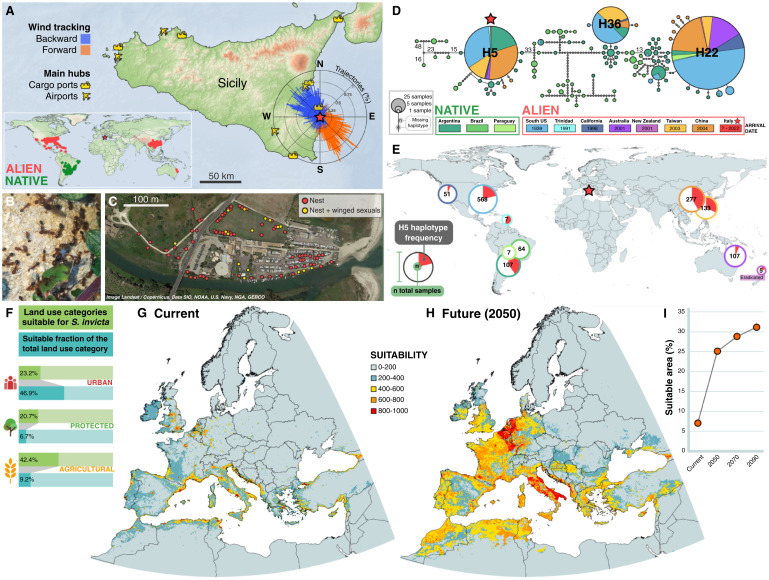The red fire ant, known scientifically as Solenopsis invicta, has now established its presence in Europe. An international study led by the Institute of Evolutionary Biology (IBE) discovered numerous colonies of this invasive species in Sicily, Italy. The red fire ant is recognized as one of the world’s most invasive species and ranks fifth in terms of the cost to combat. Genetic analyses from the study suggest that these invasive colonies in Sicily could have originated from either China or the United States.
Alarmingly, half of Europe’s urban areas, including major cities like Barcelona, Madrid, Rome, Paris, and London, are suitable habitats for the red fire ant. The study was published in the esteemed journal, Current Biology, and was a collaborative effort involving institutions like the Spanish National Research Council (CSIC) and Pompeu Fabra University (UPF). The red fire ant’s sting can cause painful pustules, allergic reactions, and in severe cases, anaphylactic shock.

In less than 100 years, this ant species has spread across the United States, Mexico, the Caribbean, China, Taiwan, and Australia. The only country that has successfully eradicated the red fire ant is New Zealand. The United States faces an estimated loss of nearly six billion euros annually due to the red fire ant. Australia spends millions on eradication efforts, but with limited success. Prior to this study, the red fire ant had been sporadically found in imported products in countries like Spain, Finland, and the Netherlands.
The colonies in Sicily are situated in a suburban area near the city of Syracuse, encompassing an estuary and a natural park. Wind direction analyses suggest that flying queen ants might have come from the northwest, specifically from the port of Syracuse. The study’s ecological models predict that climate change could further facilitate the ant’s colonization in Europe.
Similar Posts
The red fire ant, originally from South America, has significantly impacted ecosystems, agriculture, and human health in various countries. The ant’s rapid spread in the past century includes regions like the United States, Mexico, the Caribbean, China, Taiwan, and Australia. The study in Current Biology reports the establishment of S. invicta in Europe, marking its first known presence on the continent.
Genetic analyses were used to trace its potential origin, and the results indicate that half of Europe’s urban areas are already suitable for this invasive species. Climate change trends suggest that the ant’s expansion in Europe will likely continue. The ant’s presence in Sicily was confirmed with the discovery of 88 nests spread over approximately 4.7 hectares during the winter of 2022/2023. Locals in the area reported frequent ant stings since 2019, indicating a prolonged presence of the species.
The Augusta port, a major cargo harbor located about 13 km north of the invaded site, might have played a role in the ant’s introduction to Sicily. The ant’s dispersal during nuptial flights is often aided by wind patterns. The study confirmed the polygyny of the Sicilian population, meaning colonies can host multiple queens. Genetic data has shown that the global invasion of the red fire ant began with its introduction from northeastern Argentina to the southern US. The Italian population of the ant shares a mitochondrial haplotype found in populations in the southern US, mainland China, and Taiwan.
Environmental suitability assessments suggest that the ant could establish in about 7% of Europe and the Mediterranean region. Coastal Mediterranean cities, which are well-connected by seaports, are particularly vulnerable to the ant’s invasion. Future projections based on climate change depict a grim scenario with a significant increase in the ant’s suitable range.
“Coordinated efforts for early detection and rapid response in the region are essential to successfully manage this new threat,” warns Roger Vila, principal investigator at the IBE. Mattia Menchetti, an INPhINIT ”la Caixa” pre-doctoral researcher at IBE, emphasizes the public’s role in detecting the ant due to its painful stings and distinctive nest mounds. Given the ant’s dispersal capabilities, monitoring should be expanded over a larger geographical area. The study received support from the ”la Caixa” Foundation and other organizations.
The red imported fire ant is classified as one of the worst invasive alien species, with significant impacts on ecosystems, agriculture, and human health. The ant’s establishment in Europe is a cause for concern, especially considering its potential to spread further due to climate change. The species’ introduction and spread in Europe could have severe ecological and economic implications. The ant’s painful sting and aggressive nature could impact the lifestyles of residents in affected urban areas.
The study’s findings underscore the urgent need for proactive measures to contain the spread of this invasive species. The red fire ant’s establishment in Europe is a testament to the challenges posed by invasive species in a globalized world. The research highlights the importance of international collaboration in addressing the threats posed by invasive species. As the red fire ant continues its global march, Europe must brace itself for the challenges ahead.


















